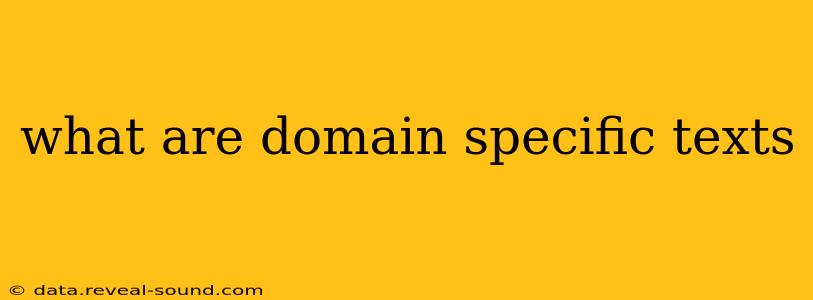What are Domain-Specific Texts?
Domain-specific texts, also known as specialized texts, are written communications tailored to a particular field of study, profession, or area of expertise. Unlike general-purpose writing, they utilize specialized vocabulary, structures, and conventions understood primarily by those within that specific domain. Think of them as the language of experts, crafted for experts and those seeking in-depth knowledge within a niche subject.
Understanding domain-specific texts is crucial for professionals and students alike. Whether you're a doctor deciphering a medical report, an engineer reviewing technical specifications, or a lawyer analyzing a legal document, navigating these texts is integral to your success. Let's delve deeper into their characteristics and examples.
What are the key characteristics of domain-specific texts?
Domain-specific texts are characterized by several key features:
-
Specialized Vocabulary: They employ technical jargon, acronyms, and specialized terminology unique to the field. For instance, a medical text will use terms like "hepatomegaly" or "tachycardia" that are unlikely to be understood by someone outside the medical profession.
-
Precise and Concise Language: Ambiguity is avoided. The language is direct, factual, and aims for clarity within the specific context. Word choice is crucial for accurate conveyance of information.
-
Specific Structures and Formats: The organization and structure often follow established conventions within the domain. A scientific paper, for example, usually follows a structured format including abstract, introduction, methods, results, and discussion. Legal documents have their own set of stylistic and structural conventions.
-
Referencing and Citations: Domain-specific texts frequently include references and citations to support claims and establish credibility, often adhering to specific citation styles (e.g., APA, MLA, Chicago).
-
Visual Aids: Graphics, diagrams, charts, and tables are often used to supplement textual information and facilitate understanding of complex concepts. These visuals are integral to conveying data and processes effectively.
What are some examples of domain-specific texts?
The range of domain-specific texts is vast, spanning numerous fields:
- Legal Texts: Contracts, statutes, legal briefs, court decisions.
- Medical Texts: Medical reports, research papers, patient charts, pharmaceutical instructions.
- Technical Texts: Engineering manuals, software documentation, scientific articles, technical specifications.
- Financial Texts: Investment reports, financial statements, economic analyses, tax documents.
- Educational Texts: Textbooks, academic papers, lecture notes, research proposals.
How do domain-specific texts differ from general texts?
The primary difference lies in the audience and purpose. General texts aim for broad accessibility, using simple language and avoiding specialized terminology. Domain-specific texts, conversely, are targeted at a specialized audience familiar with the field's vocabulary and conventions. The purpose is highly focused—to convey complex information precisely and efficiently within the domain's context.
What are some challenges in understanding domain-specific texts?
Understanding domain-specific texts can be challenging, even for those within the field. Key challenges include:
- Specialized Vocabulary: The dense use of jargon can make texts difficult to decipher for those unfamiliar with the terminology.
- Complex Sentence Structures: Sentences may be lengthy and complex, requiring careful reading and analysis.
- Abstract Concepts: The subject matter itself can be inherently complex and require significant prior knowledge to grasp fully.
How can I improve my understanding of domain-specific texts?
Improving comprehension requires a multi-faceted approach:
- Build Background Knowledge: Familiarize yourself with the key concepts and terminology of the domain.
- Use Reference Materials: Utilize dictionaries, glossaries, and encyclopedias to look up unfamiliar terms.
- Read Actively: Take notes, highlight key passages, and summarize complex ideas.
- Seek Clarification: Don't hesitate to ask for help from experts or peers if needed.
In conclusion, domain-specific texts are essential tools for communication and knowledge dissemination within specialized fields. Understanding their characteristics and employing effective reading strategies are crucial for navigating these texts successfully.
